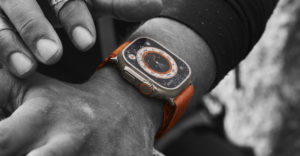
Smartphones have been steadily stealing shutterbugs from digital camera makers, but most of those converts are coming from the point-and-shoot snapper crowd. The next step for phone makers is to target more sophisticated photographers who use cameras with interchangeable lenses. Apple appears to be getting ready for that battle.
The United States Patent and Trademark Office on Tuesday awarded Apple two patents that would allow lenses to be attached to a mobile device, such as an iPhone, either through a plate that attaches to the back of the device or through magnets.
U.S. Patent No. 8,638,369 for a “back panel for a portable electronic device with different camera lens options” would create a digital imaging subsystem that gives a “highly compact device,” such as a smartphone, features found in high-end digital cameras.
Lenses in such a subsystem can be much smaller than those in a dedicated camera, Apple’s patent application explains. Moreover, the subsystem can be used to add to a phone’s camera features such as optical image stabilization, an optical zoom, faster shutter speeds and strobe flash.
Pros Not Target
Patent No. 8,639,106 for “magnetic add-on lenses with alignment ridge” would provide a lens mount for compact devices that allow an add-on lens to work accurately with the lens built into the device.
“Existing compact devices that use compact camera modules generally do not provide the types of lens mounting structures found in conventional cameras due to space constraints,” Apple’s patent application notes. “This makes it difficult to retain an additional lens and align it correctly with a compact camera module on a compact device.”
Apple’s lens assembly includes a lamp for illuminating subjects and a microphone for capturing sound while using add-on lenses.
Whether Apple chooses to use these patents down the road is unknown, but they do reveal that it is thinking about where smartphone photography is headed.
“Mobile photography has already eaten quite a bit of the point-and-shoot market, because the best camera you have is the camera you have with you,” Michael Morgan, an independent mobile devices analyst, told TechNewsWorld.
“Apple is going after hobbyists with these patents,” he said. “This isn’t preparing for a full professional replacement yet — that would be the step after this.”
Kludgy Add-Ons
Digital cameras with interchangeable lenses are the next logical target for smartphone makers.
“It’s one of the few provinces of traditional digital camera makers that has been out of the reach of competition with smartphones,” Ross Rubin, the principal analyst at Reticle Research, told TechNewsWorld.
“Smartphones are already good enough to serve as the primary camera for many consumers,” he added.
Camera makers haven’t been totally blind to the wants of smartphone owners for better optics. Sony, for example, has introduced two smartphone add-on cameras — the QX10 and QX100 — that add features like powerful image processing and optical zooms to a smartphone camera.
“A lot of those add-ons to date are a little kludgy,” Morgan said. “Apple’s patents promise to deliver a simpler interchange process between lenses.”
Without a doubt, smartphone shooters are starting to clamor for features beyond what’s packaged with a typical mobile.
“Going forward, people want more options because there are so many photos being taken, and they all have that 24-28mm field of view,” said Stan Horaczek, online editor for Popular Photography.
“People want to do more than what they can do with their iPhone camera,” he told TechNewsWorld.
“It’ll be interesting to see if people will start using cameras tethered to their phones and beaming photos, which is getting easier,” he said, “or if Apple or somebody else can step in and do it right at the phone level.”





















































